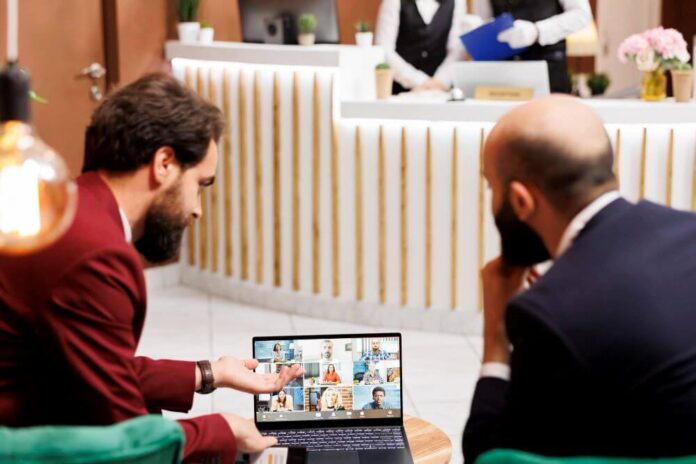Hybrid events have moved well beyond the realm of stopgap solutions. What started as a necessary pivot during the pandemic has since solidified into a powerful and enduring format—one that merges physical presence with digital reach.
Sure, the initial spike in popularity was fuelled by necessity. But what’s kept the hybrid model alive is something deeper: broader access, increased flexibility, and the kind of data-rich insight that purely in-person events can rarely offer.
As hybrid events become the norm rather than the novelty, an important question is beginning to surface: Are we designing for two distinct audiences—or aiming to create a unified experience that works for everyone, everywhere?
It’s not just a technical puzzle. It’s a strategic one. And how we answer it will shape the future of events. The Chameleon Agency event designer in Manchester created this guide to help event planners navigate those decisions with clarity and confidence.
Two Audiences, Two Realities
Hybrid events naturally divide their attendees into two camps:
- Those in the room, looking for tactile, high-energy, people-first experiences.
- And those tuning in remotely, expecting seamless digital delivery, intuitive interaction, and something that feels engaging—even from their living room.
And these aren’t just stylistic preferences. They’re entirely different ways of engaging. For too many events, the result is a kind of imbalance: a well-orchestrated in-person experience paired with an underwhelming livestream that feels like an afterthought.
That’s where experience equity comes in—the idea that both groups should receive a comparable level of value, even if the delivery differs. And achieving that balance? Not so simple.
What UX Can Teach Us About Hybrid Events
Interestingly, this isn’t a new problem—it’s just new to event organisers. UX designers have been solving this for years, creating fluid, consistent experiences across mobile, desktop, tablet and even wearables.
The key idea? One experience, multiple interfaces. Regardless of how someone accesses a platform, the feel and flow should be coherent.
That same thinking applies beautifully to hybrid events. Enter adaptive event design: a strategy where the delivery might change, but the goals, energy and storytelling stay consistent.
If you reframe a hybrid event as an interactive ecosystem—rather than two separate tracks—it becomes easier to design something that feels connected rather than cobbled together.
Intentional Design: Diverge First, Then Converge
The most successful hybrid events do one thing exceptionally well: they start by acknowledging the differences between their audiences, and then deliberately design opportunities to bring them back together.
Start with Divergence
Play to each audience’s strengths. Give your in-person guests those hands-on moments, from immersive exhibits to real-time networking. But for your virtual crowd, offer tailored perks—like exclusive backstage interviews, digital Q&As, or content they can access on-demand.
Then Create Points of Convergence
Moments of connection matter. Use real-time polling or chat tools to get both audiences involved in the same conversation. Stream headline speakers to both groups. Set up shared breakout sessions or hybrid lounges where remote and in-person guests can interact.
Take Cisco Live 2023, for instance. They ran a “digital-first” content track alongside the in-person experience—and saw a 30% boost in remote engagement by giving online viewers content that complemented, rather than copied, the live programme (Cisco Newsroom).
The Real Issue Isn’t Tech—It’s Design
It’s tempting to blame clunky platforms or bad Wi-Fi when a hybrid event doesn’t land. But that’s rarely the real culprit.
Today’s top hybrid platforms—Hopin, Cvent, Bizzabo, vFairs—can do far more than just stream video. They support chat, live polling, networking spaces, analytics, even gamification. The tools are there.
The problem? Most organisers haven’t yet shifted their design mindset. Tech is just the scaffolding. It’s how you use it that makes the experience matter.
How Do You Know It’s Working? Look at the Right Metrics
Traditional event metrics—headcounts, survey scores—only scratch the surface when it comes to hybrid success. To really understand how both audiences are engaging, we need smarter KPIs:
- Remote Engagement Duration: Are digital attendees sticking around, or zoning out after 10 minutes?
- Simultaneous Engagement: Are both audiences interacting at the same time? Or is one always just watching passively?
- Format Effectiveness: Is a panel discussion performing better live or online? Are interactive formats outperforming lectures?
- Participation Parity: Are both groups equally able to contribute, ask questions, and shape the event experience?
Platforms like SpotMe and Brella have started offering live dashboards to help track these metrics—giving organisers the insight to pivot in real time.
A More Inclusive, Sustainable Future
When they’re done right, hybrid events aren’t just logistically smart—they’re ethically powerful.
They remove the cost, visa, health, and time barriers that keep many people from attending in person. They let someone in Nairobi, Naples or Newcastle have the same access as someone in Notting Hill.
They’re greener, too. A 2023 study by the Virtual Events Institute found that making remote access the default could slash carbon emissions by up to 80% per attendee.
And let’s not forget accessibility. Online formats make it easier to offer closed captions, translation services, screen readers and other assistive tech—making events more inclusive than ever before.
The Bottom Line: One Experience, Two Lenses
The future of hybrid isn’t about choosing between audiences. It’s about designing one experience, expressed through two lenses.
It calls for a different mindset—one that puts the audience, not the venue, at the centre of the experience.
And those who get it right? They won’t just reach more people. They’ll leave a lasting impression on all of them.







